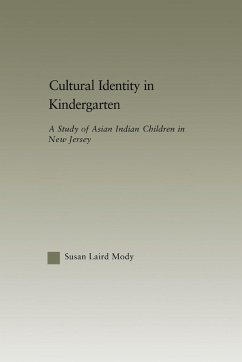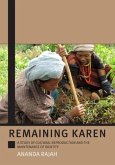- Broschiertes Buch
- Merkliste
- Auf die Merkliste
- Bewerten Bewerten
- Teilen
- Produkt teilen
- Produkterinnerung
- Produkterinnerung
First Published in 2005. Routledge is an imprint of Taylor & Francis, an informa company.
Andere Kunden interessierten sich auch für
![Negotiating Identity In Contemporary Japan Negotiating Identity In Contemporary Japan]() PangNegotiating Identity In Contemporary Japan50,99 €
PangNegotiating Identity In Contemporary Japan50,99 €![Remaining Karen: A Study of Cultural Reproduction and the Maintenance of Identity Remaining Karen: A Study of Cultural Reproduction and the Maintenance of Identity]() Ananda RajahRemaining Karen: A Study of Cultural Reproduction and the Maintenance of Identity29,99 €
Ananda RajahRemaining Karen: A Study of Cultural Reproduction and the Maintenance of Identity29,99 €![Mixed Race Identities in Asia and the Pacific Mixed Race Identities in Asia and the Pacific]() Zarine L RochaMixed Race Identities in Asia and the Pacific50,99 €
Zarine L RochaMixed Race Identities in Asia and the Pacific50,99 €![Collective Rights of Indigenous Peoples Collective Rights of Indigenous Peoples]() Jolan HsiehCollective Rights of Indigenous Peoples69,99 €
Jolan HsiehCollective Rights of Indigenous Peoples69,99 €![Cultural Sociology of the Middle East, Asia, and Africa Cultural Sociology of the Middle East, Asia, and Africa]() Cultural Sociology of the Middle East, Asia, and Africa731,99 €
Cultural Sociology of the Middle East, Asia, and Africa731,99 €![Social Attitudes in Contemporary China Social Attitudes in Contemporary China]() Chen YuSocial Attitudes in Contemporary China30,99 €
Chen YuSocial Attitudes in Contemporary China30,99 €![Relocating Cultural Studies Relocating Cultural Studies]() Relocating Cultural Studies19,99 €
Relocating Cultural Studies19,99 €-
-
-
First Published in 2005. Routledge is an imprint of Taylor & Francis, an informa company.
Hinweis: Dieser Artikel kann nur an eine deutsche Lieferadresse ausgeliefert werden.
Hinweis: Dieser Artikel kann nur an eine deutsche Lieferadresse ausgeliefert werden.
Produktdetails
- Produktdetails
- Verlag: Taylor & Francis
- Seitenzahl: 252
- Erscheinungstermin: 29. Oktober 2012
- Englisch
- Abmessung: 229mm x 152mm x 13mm
- Gewicht: 340g
- ISBN-13: 9780415649001
- ISBN-10: 0415649005
- Artikelnr.: 36540345
- Herstellerkennzeichnung
- Libri GmbH
- Europaallee 1
- 36244 Bad Hersfeld
- gpsr@libri.de
- Verlag: Taylor & Francis
- Seitenzahl: 252
- Erscheinungstermin: 29. Oktober 2012
- Englisch
- Abmessung: 229mm x 152mm x 13mm
- Gewicht: 340g
- ISBN-13: 9780415649001
- ISBN-10: 0415649005
- Artikelnr.: 36540345
- Herstellerkennzeichnung
- Libri GmbH
- Europaallee 1
- 36244 Bad Hersfeld
- gpsr@libri.de
Susan Laird Mody
Acknowledgements Abstract List of Tables 1. Introduction and Methodology
Statement of the Problem Research Questions Conceptual Framework Settings
Methodology 2. Literature Review Cultural Identity in Social Worlds
Children in Social Worlds Play and Discourse Studies in Ethnicity Asian
Cultural Identity 3. Stony Brook: Stepping Stone to Success School Context:
Constraint, Memory and Diversity Classroom Culture: Private Offices and
Memory Machines Peer Interactions: Team and Familial Networking Styles Home
is a Different Story The Ascriptive-Assertive Identity Stream Convergence
of Voice in Rhetorical Practice 4. Fair Bridge: Trying to Mix School
Context: Learning to be Friendly Classroom Culture: Time for Talk and Work
Peer Interactions: Role Elaborations in Play Networks Visible Families,
Separate Neighborhoods Identities in Dialogic Streams Varieties in
Expressive Practice 5. Glimpses of Indian Familial Contexts Amalgamating,
Incorporating and Proliferating Identity Interests Local Views of Indian
Family Relationship Styles General Patterns in Talk and Play 6. Cultural
Recognitions Harmonies: Mirroring Selves Discords: Constructing Safety
Zones Boundary Work in Comic, Scary and Moral Discourse Kindergarten
Ontologies 7. Conclusions Summary Implications References A ppendices A.
Parent Consent Form B. Parent Consent Form in Spanish C. Stony Brook
Demographics D. Fair Bridge Demographics
Statement of the Problem Research Questions Conceptual Framework Settings
Methodology 2. Literature Review Cultural Identity in Social Worlds
Children in Social Worlds Play and Discourse Studies in Ethnicity Asian
Cultural Identity 3. Stony Brook: Stepping Stone to Success School Context:
Constraint, Memory and Diversity Classroom Culture: Private Offices and
Memory Machines Peer Interactions: Team and Familial Networking Styles Home
is a Different Story The Ascriptive-Assertive Identity Stream Convergence
of Voice in Rhetorical Practice 4. Fair Bridge: Trying to Mix School
Context: Learning to be Friendly Classroom Culture: Time for Talk and Work
Peer Interactions: Role Elaborations in Play Networks Visible Families,
Separate Neighborhoods Identities in Dialogic Streams Varieties in
Expressive Practice 5. Glimpses of Indian Familial Contexts Amalgamating,
Incorporating and Proliferating Identity Interests Local Views of Indian
Family Relationship Styles General Patterns in Talk and Play 6. Cultural
Recognitions Harmonies: Mirroring Selves Discords: Constructing Safety
Zones Boundary Work in Comic, Scary and Moral Discourse Kindergarten
Ontologies 7. Conclusions Summary Implications References A ppendices A.
Parent Consent Form B. Parent Consent Form in Spanish C. Stony Brook
Demographics D. Fair Bridge Demographics
Acknowledgements Abstract List of Tables 1. Introduction and Methodology
Statement of the Problem Research Questions Conceptual Framework Settings
Methodology 2. Literature Review Cultural Identity in Social Worlds
Children in Social Worlds Play and Discourse Studies in Ethnicity Asian
Cultural Identity 3. Stony Brook: Stepping Stone to Success School Context:
Constraint, Memory and Diversity Classroom Culture: Private Offices and
Memory Machines Peer Interactions: Team and Familial Networking Styles Home
is a Different Story The Ascriptive-Assertive Identity Stream Convergence
of Voice in Rhetorical Practice 4. Fair Bridge: Trying to Mix School
Context: Learning to be Friendly Classroom Culture: Time for Talk and Work
Peer Interactions: Role Elaborations in Play Networks Visible Families,
Separate Neighborhoods Identities in Dialogic Streams Varieties in
Expressive Practice 5. Glimpses of Indian Familial Contexts Amalgamating,
Incorporating and Proliferating Identity Interests Local Views of Indian
Family Relationship Styles General Patterns in Talk and Play 6. Cultural
Recognitions Harmonies: Mirroring Selves Discords: Constructing Safety
Zones Boundary Work in Comic, Scary and Moral Discourse Kindergarten
Ontologies 7. Conclusions Summary Implications References A ppendices A.
Parent Consent Form B. Parent Consent Form in Spanish C. Stony Brook
Demographics D. Fair Bridge Demographics
Statement of the Problem Research Questions Conceptual Framework Settings
Methodology 2. Literature Review Cultural Identity in Social Worlds
Children in Social Worlds Play and Discourse Studies in Ethnicity Asian
Cultural Identity 3. Stony Brook: Stepping Stone to Success School Context:
Constraint, Memory and Diversity Classroom Culture: Private Offices and
Memory Machines Peer Interactions: Team and Familial Networking Styles Home
is a Different Story The Ascriptive-Assertive Identity Stream Convergence
of Voice in Rhetorical Practice 4. Fair Bridge: Trying to Mix School
Context: Learning to be Friendly Classroom Culture: Time for Talk and Work
Peer Interactions: Role Elaborations in Play Networks Visible Families,
Separate Neighborhoods Identities in Dialogic Streams Varieties in
Expressive Practice 5. Glimpses of Indian Familial Contexts Amalgamating,
Incorporating and Proliferating Identity Interests Local Views of Indian
Family Relationship Styles General Patterns in Talk and Play 6. Cultural
Recognitions Harmonies: Mirroring Selves Discords: Constructing Safety
Zones Boundary Work in Comic, Scary and Moral Discourse Kindergarten
Ontologies 7. Conclusions Summary Implications References A ppendices A.
Parent Consent Form B. Parent Consent Form in Spanish C. Stony Brook
Demographics D. Fair Bridge Demographics








